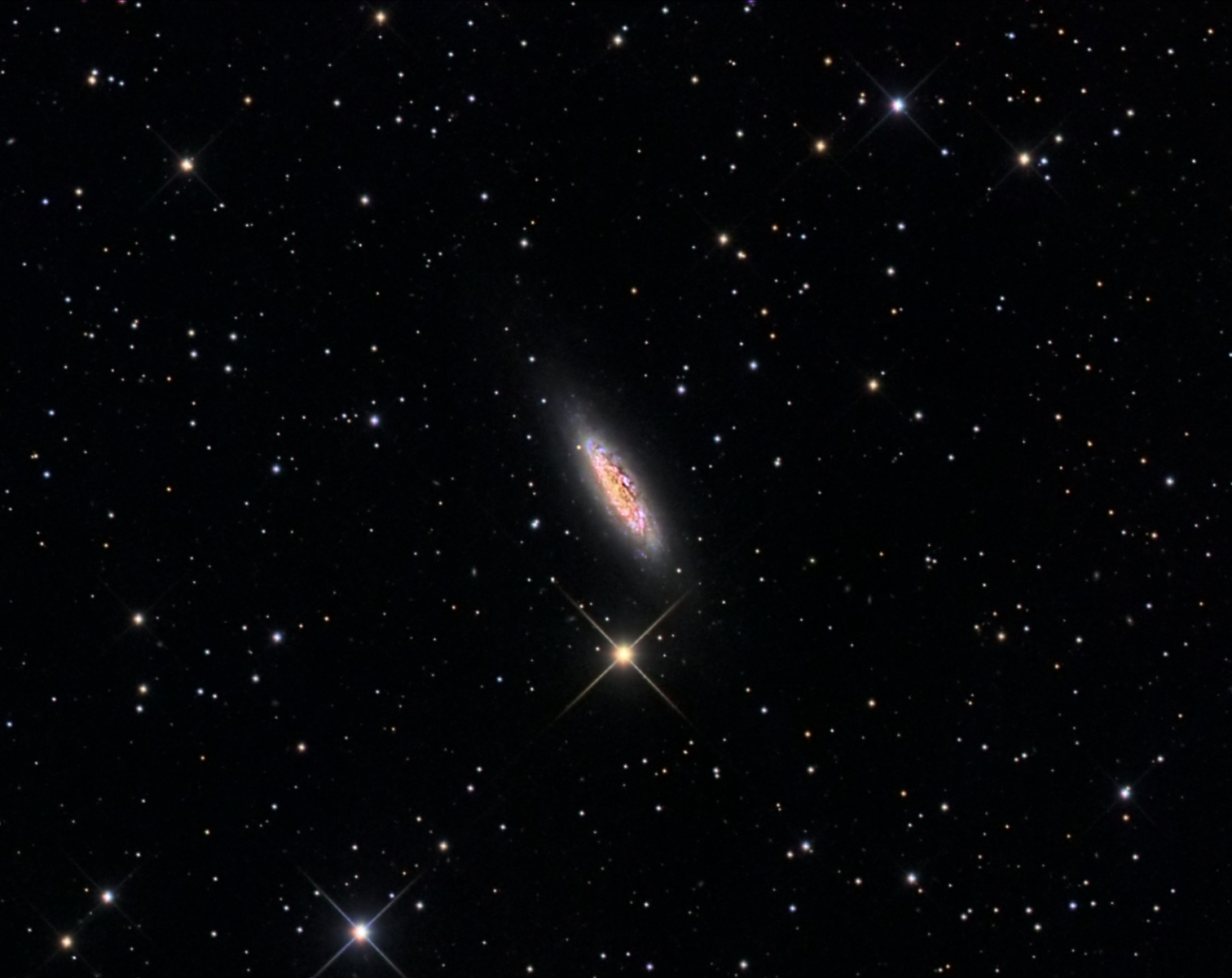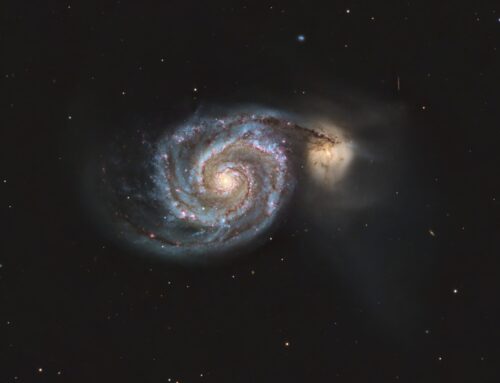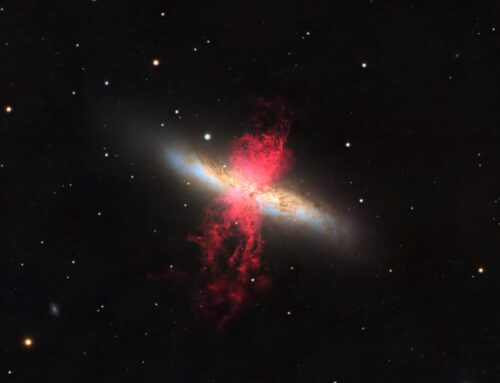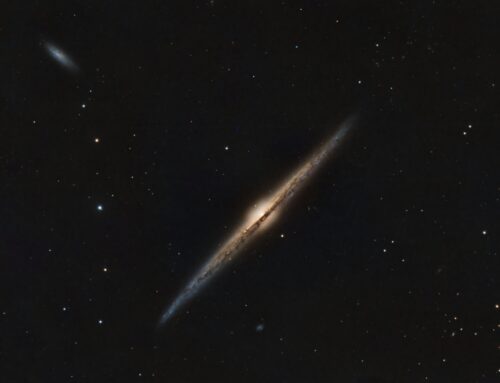NGC6503, Dwarf Spiral Galaxy
 Click image for full size version
Click image for full size version
July 19, 2015, Astronomy.com online Picture of the Day, August 26, 2015; Journal of the Royal Astronomical Society, Oct. 2015

 This interesting object is dwarf spiral galaxy NGC6503. Every star that you see in this image is in the foreground, with the galaxy far in the distance at around 17 million light years. NGC6503 is a “field galaxy” meaning that it is alone, not gravitationally associated with any other galaxy. The pink, blue and dark patches in the galaxy correspond to the Milky Way’s emission nebulae, star clusters and dust lanes.
This interesting object is dwarf spiral galaxy NGC6503. Every star that you see in this image is in the foreground, with the galaxy far in the distance at around 17 million light years. NGC6503 is a “field galaxy” meaning that it is alone, not gravitationally associated with any other galaxy. The pink, blue and dark patches in the galaxy correspond to the Milky Way’s emission nebulae, star clusters and dust lanes.
This object is at the edge of a region of space called the Local Void, a vast almost empty region of space that may be as big as 150 million light years by 230 million light years. The galaxy is puny in comparison with a diameter of a mere 30,000 light years. Voids happen in space due to the tendency of matter to clump together, including galaxies. Galaxy clusters are areas where the abundance of matter is relatively high; voids are deficient in galaxies as a result.
If you were on a ship, this galaxy might be the last outpost for stocking up with supplies before entering the Local Void. I think that would make an excellent storyline for a Star Trek episode, but perhaps I am too late…
Tekkies:
SBIG STL-11000M camera, Baader Ha, L, R, G and B filters, 10″ f/6.8 ASA astrograph, Paramount MX. Guided with STL-11000’s external guider and 80 mm f/6 Stellar-Vue refractor. Acquisition and guiding with TheSkyX. Focusing with FocusMax. Automation with CCDCommander. Calibration, cosmetic correction, registration, integration and all processing in PixInsight. Shot from my SkyShed in Guelph, Ontario. No moon for L, R, G, B; moderate moonlight for Ha. Very good transparency and good to very good seeing throughout acquisition.
8x20m Ha, 11x10m R, 10x10mG, 9x10mB and 42x10mL unbinned frames (total=14hr40m).
Initial Processing:
Ha, L, R, G and B masters were cropped and processed separately with DBE.
HaRGB
R, G and B were combined to make an RGB image which was processed with DBE and ColourCalibration. The NB-RGBCombine Script was applied with default settings to produce a linear HaRGB image.
A copy of the Ha was stretched and then adjusted with curves to make a mask for the Ha knots in the galaxy. PixelMath was used to replace pixels in the RGB image with NBRGBCombination pixels, protecting all but the Ha knots with the mask.
MultiscaleLinearTransform was used to reduce noise in the background areas. HistogramTransformation was applied to make a pleasing yet bright image. TGV Noise was applied and the image was re-stretched to reset the black point.
Contrast and saturation were adjusted.
Synthetic Luminance:
Creation and cleanup: The cleaned up Ha, L, R, G and B masters were combined using the ImageIntegration tool (average, additive with scaling, noise evaluation, iterative K-sigma / biweight midvariance, no pixel rejection).
Deconvolution: A copy of the image was stretched to use as a deconvolution mask. A star mask was made from unstretched L to use as a local deringing support. Deconvolution was applied (100 iterations, regularized Richardson-Lucy, external PSF made using DynamicPSF tool with about 20 stars; local deringing at 70% and global dark deringing at 0.02).
Linear Noise Reduction: MultiscaleLinearTransform was applied to reduce the noise.
Stretching: HistogramTransformation was applied to make a pleasing yet bright image. TGV Noise was applied and the image was re-stretched to reset the black point.
Combining SynthL with HaRGB:
LRGBCombine was used to apply SynthL to the RGB image.
Final Processing
HDRMultiscaleTransform was applied at 6 and 4 px scales using a mask to protect everything except the galaxy. Then LocalHistogramEqualization was applied at scales of 64 and 128 px, with a strength of 0.25 each time. Saturation of the galaxy was boosted with a curve using the same mask.
Luminance was extracted and used as a mask to boost overall star and galaxy saturation.
Star shapes were smoothed and sizes reduced by applying MorphologicalTransformation twice through the same star mask. The first pass used the Midpoint operator, with default settings. The second pass used the Erosion operator with a strength of 0.25 and 4 iterations.
UnsharpMask was applied to the brightest parts of the galaxy. A curve was applied to increase contrast.
Image scale is about 1.1 arcsec per pixel for this camera / telescope combination.






Leave A Comment